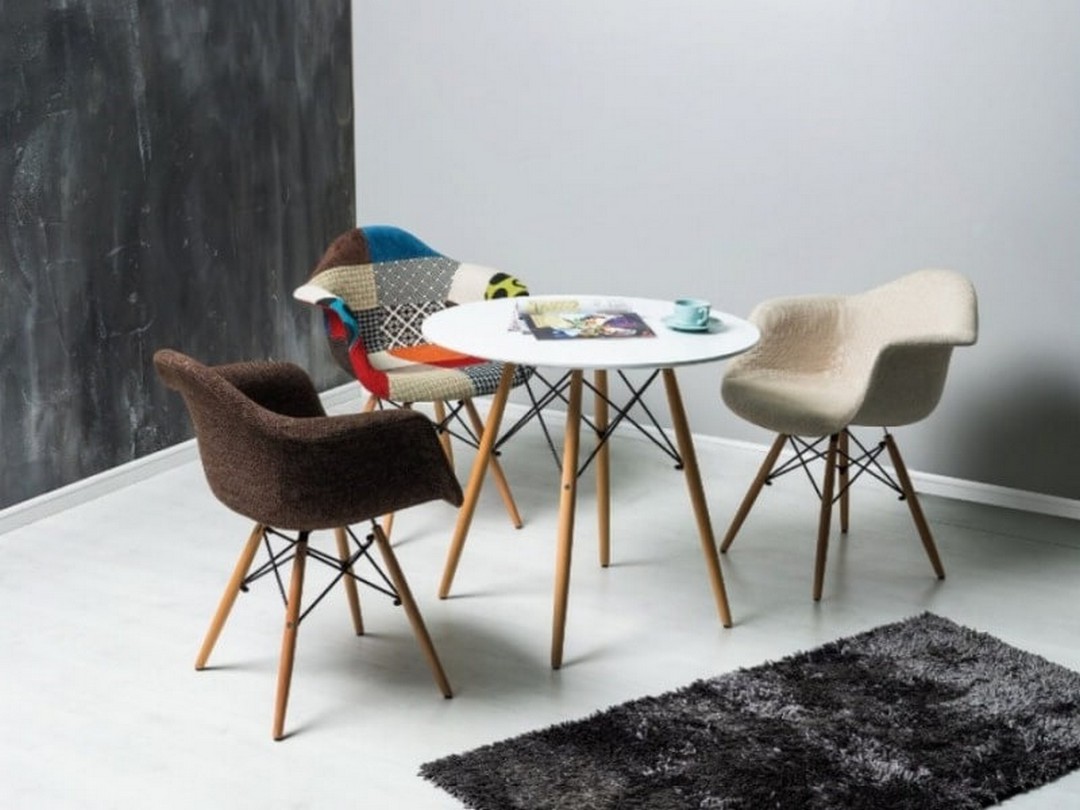
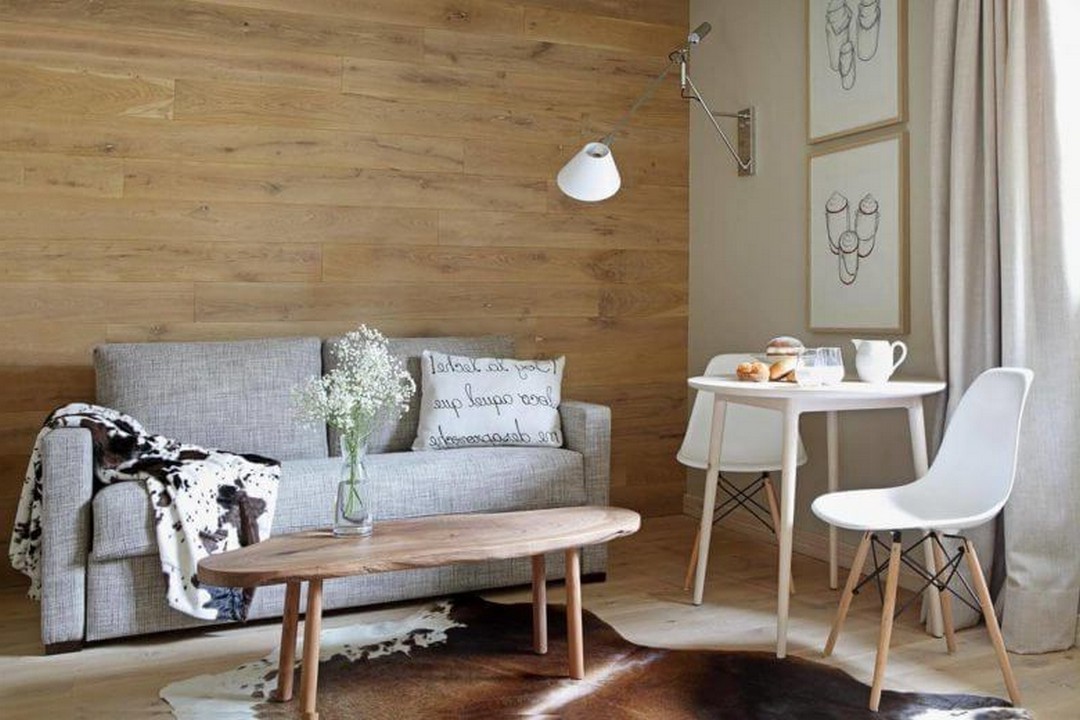
More and more people today are opting for the Scandinavian style in decorating the interior of their homes. The versatility, minimalism, functionality, and beauty of this design style cannot but attract attention. The vast array of design and décor items for this style, from large furniture to small decorative elements makes the Scandinavian style all the more alluring. If this is not enough, Scandinavian motifs present a solution to residents of small apartments or rooms with insufficient natural lighting. The ample lighting and the use of predominantly light shades, which characterize the Scandinavian style, create the impression of a large space. Most importantly, due to its versatility, the Scandinavian style suits any room, whether it is the bedroom, kitchen, living room, or even nursery.
Features of the Scandinavian style as used in the interior of a house or apartment
However, you need to note that even though the Scandinavian style prioritizes minimalism, you can still use décor elements. In fact, the Scandinavian style skillfully combines practical and aesthetic elements. You just need to use décor pieces in moderation. This way, even the smallest detail can become the highlight of the room, while allowing you to retain the Scandinavian style.
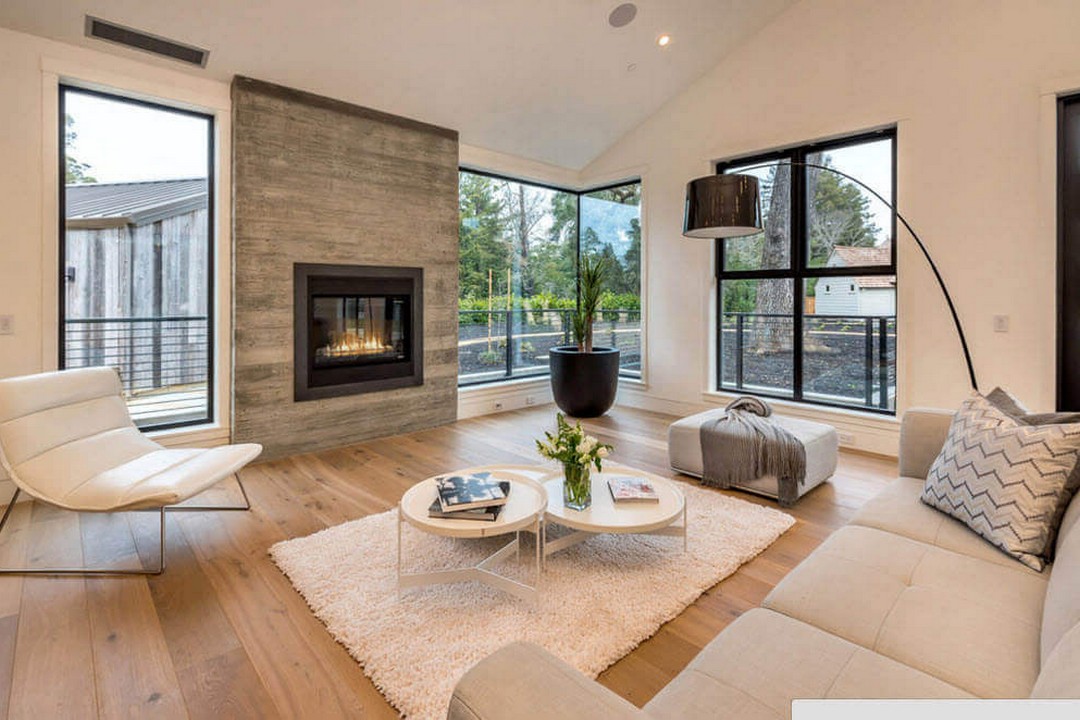
The basic principles of the Scandinavian style include:
- Provide as much natural light in as much as possible, as the light helps to visually expand the room. You can achieve this by designing the interior to have multiple large windows;
- White dominates the finishing: In addition to the usual white ceiling, designers recommend decorating all the walls in white. With this technique, you will achieve an even distribution of sunlight, since the sunlight will be reflected from the snow-white walls and spread throughout the room, creating a cozy effect.
- Use the maximum amount of natural materials: The Scandinavian style is strict on naturalness. You can achieve this quality by using pieces made from natural materials such as wood, ceramics, or stone. Designers further recommend that you use leather, fur, and natural fabrics like cotton or linen as accent details. Since natural materials are costly, you can as well go for more affordable artificial imitations if you are on a tight budget;
- Creating a feeling of spaciousness: To achieve spaciousness in a limited space, designers of the Scandinavian style often combine two or more rooms in a single space. For instance, designers often design the living room and kitchen, or the bedroom and study to interact harmoniously as a single space. Often, this combination is popular in studio apartments, where several functional zones are located in the territory of one room;
The use of simple furniture designs, which, in turn, provide comfort and practicality. In principle, functionality is the hallmark of the Scandinavian motif in the interior;
- One or two bright accents: Accents are supposed to catch the attention of the eye. The accent items popular in Scandinavian-style interiors are furniture, textiles like curtains, and pillows, indoor plants, and wall decoration elements like paintings, panels, and photographs;
- Personality: This is perhaps the most important aspect of the Scandinavian style. Everything single item in the room and its arrangement should reflect the traits of the occupants and serve as their ideal island of comfort. It is especially important that the interior represents all the basic criteria of beauty, comfort, and aesthetics associated with the Scandinavian style.
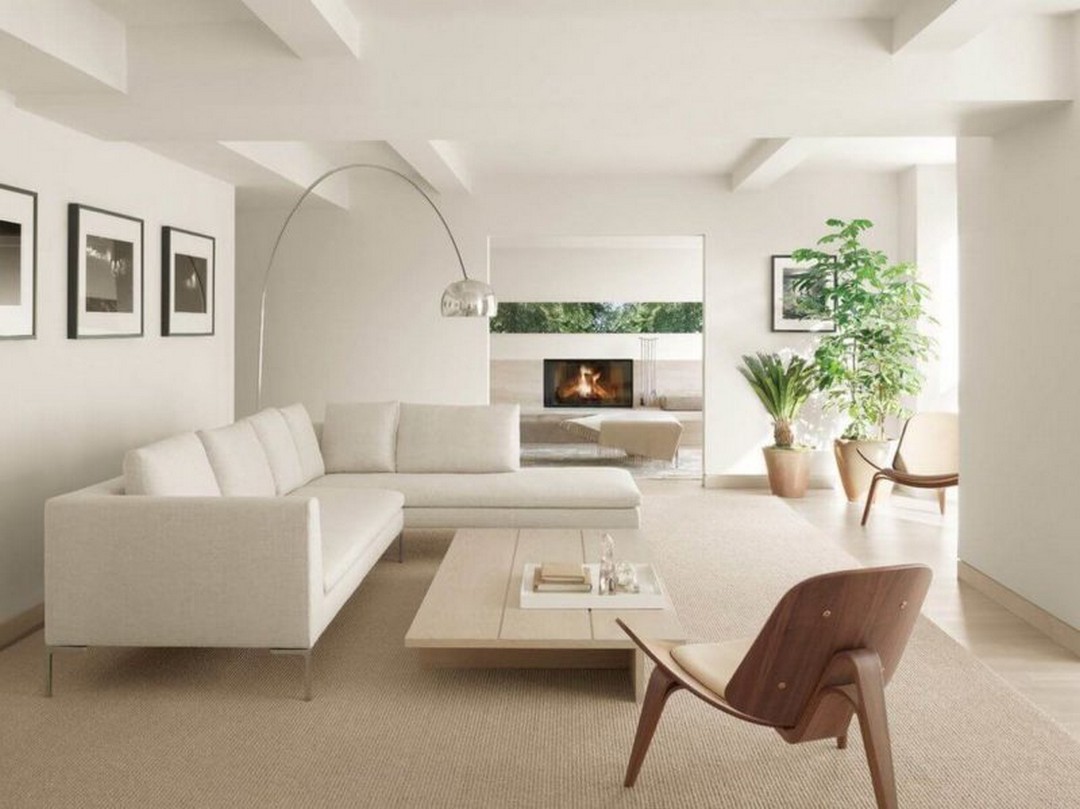
In summary, the components of a perfectly-executed Scandinavian style can be divided into various categories, as explained in the following section:
Colors
There is a popular opinion that the Nordic interior design is boring, as it mostly consists of achromatic white-gray colors. However, this opinion is absolutely wrong. With origins in the northern latitudes, where the winter palette predominates, the Scandinavian style has incorporated all the shades of the Scandinavian environment; the gray-purple and sky-blue tones of the sky, the bluish color of rocks covered with snow and shrouded in fog, velvety-green moss, pinkish reflections of the sunset on the surface of water bodies, and golden lights glowing on the shores.
If you would like to experiment with the Scandinavian style, you can start by searching photos of Nordic landscapes on the internet, then proceeding to recreate your favorite palette in the interior. It is important to take into account the proportions of your interior, as well as the influence of certain colors on the mood of the occupants. The main shades that characterize the Scandinavian style include:
- Muted white with a faint highlight of gray and yellow ;
- Bleached beige or ivory;
- Graphite gray, stone gray, granite, or greenish-gray (khaki);
- Grayish blue, plain gray, deep blue, or the tone of a cloudy sky;
- Coniferous green, olive, or the greenish-yellow color of cut grass;
- Violet-blue, dark purple, azure;
- Dusty yellow (as if a drop of gray has been added to yellow paint), mustard, gold.

Scandinavian style kitchen
Materials
Northern European interiors, which are now at the peak of popularity in many countries around the world, extreme importance is attached to natural textures. Natural textiles are ideal for use in Scandinavian interiors as they create a warm and comfortable environment that allows occupants to get the best relaxation. Unlike synthetics, natural materials give a pleasant feeling of comfort and security.
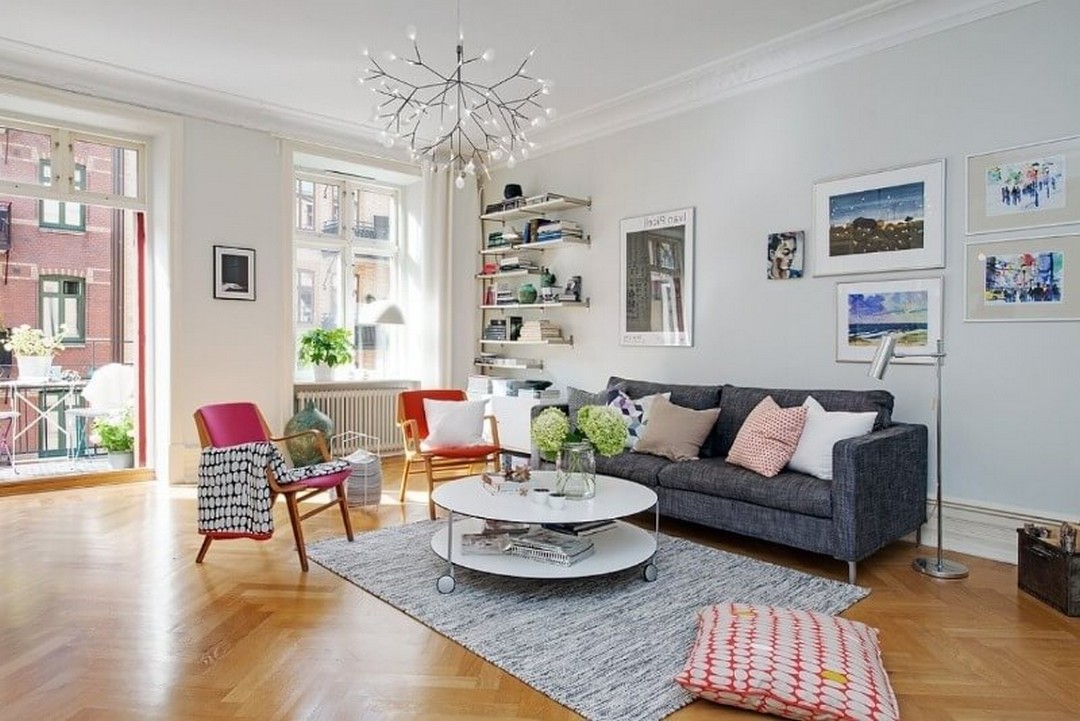
Given its simple and environmentally-friendly approach, the Scandinavian design deprives the home of the deliberate luxury that characterizes other interior design styles. The Scandinavian style also lacks ultramodern or futuristic elements like touch panels, glass partitions, or streamlined plastic shapes. Instead, the style features the following elements:
- Light-colored unprocessed wood on the floor, countertops, and beams;
- Plain paint (whitewashing) on the walls and ceiling;
- Ceramic tile “wild boar”, often in square shapes and with soft patchwork patterns;
- Porcelain tiles with a texture of wood or stone like marble or granite;
- Items made of non-chrome steel or other metal painted in matte black;
- Shine-free soft fabrics such as dense cotton, linen, velvet, jacquard, plush blankets, and woolen rugs with ethnic northern patterns.
Furniture
IKEA has long been a trendsetter for Scandinavian-style furniture. The simplicity and lightness of IKEA’s have gained the brand immense popularity throughout Europe. However, furnishings similar to those sold in IKEA can easily be found in other furniture stores or workshops.
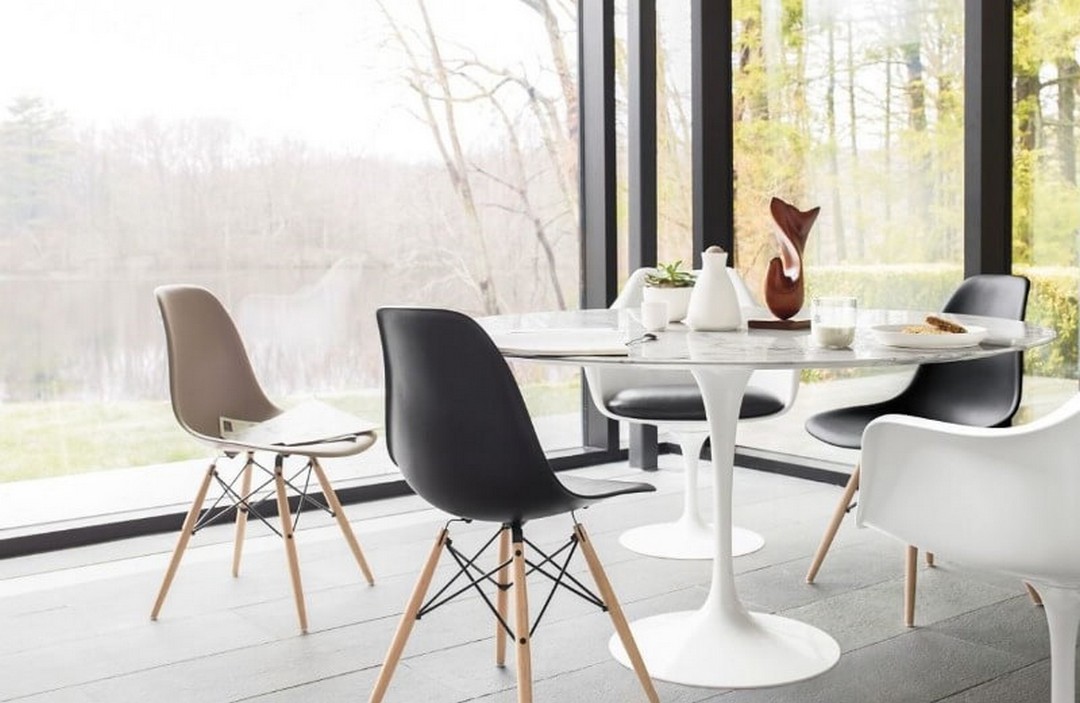
Upholstered Scandinavian-style furniture looks simple and compact. Scandinavian-style furniture is typically foldable and has low legs. The shape of the furniture tends to be rectangular, with slightly smoothed corners. Plain natural fabrics like linen or cotton are used for upholstery, but fabrics like velour are not popular.
Tables, chairs, and stools for Scandinavian interiors are distinguished by their special leg positioning. The stands for this furniture are not located directly below the furniture, but instead, are positioned to form trapezoidal shapes. Other times, the legs are connected crosswise with thin jumpers made of ferrous metal. The back and seat for such furniture are fused to form a slight tilt.

The facades of the cabinets are often matte, paneled, and with inconspicuous miniature handles. Doors often lack decorative or glass inserts. Open shelves in Nordic interiors are rare, with the exception of compact cabinets or thin hinged slots for minute items.
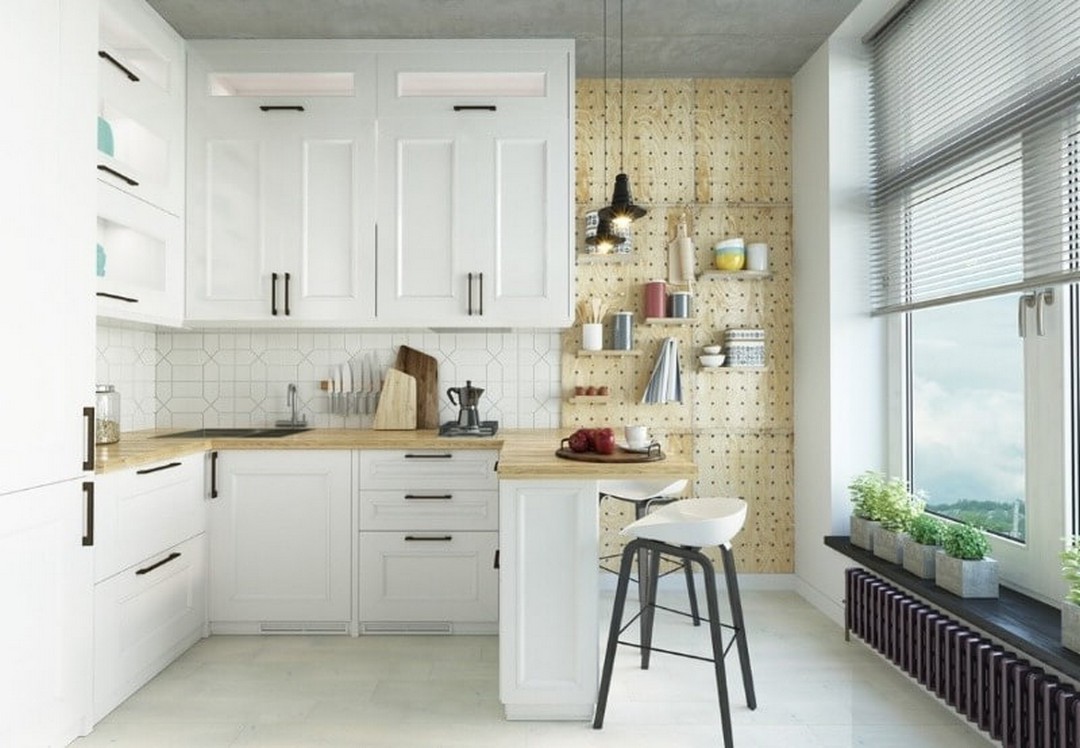
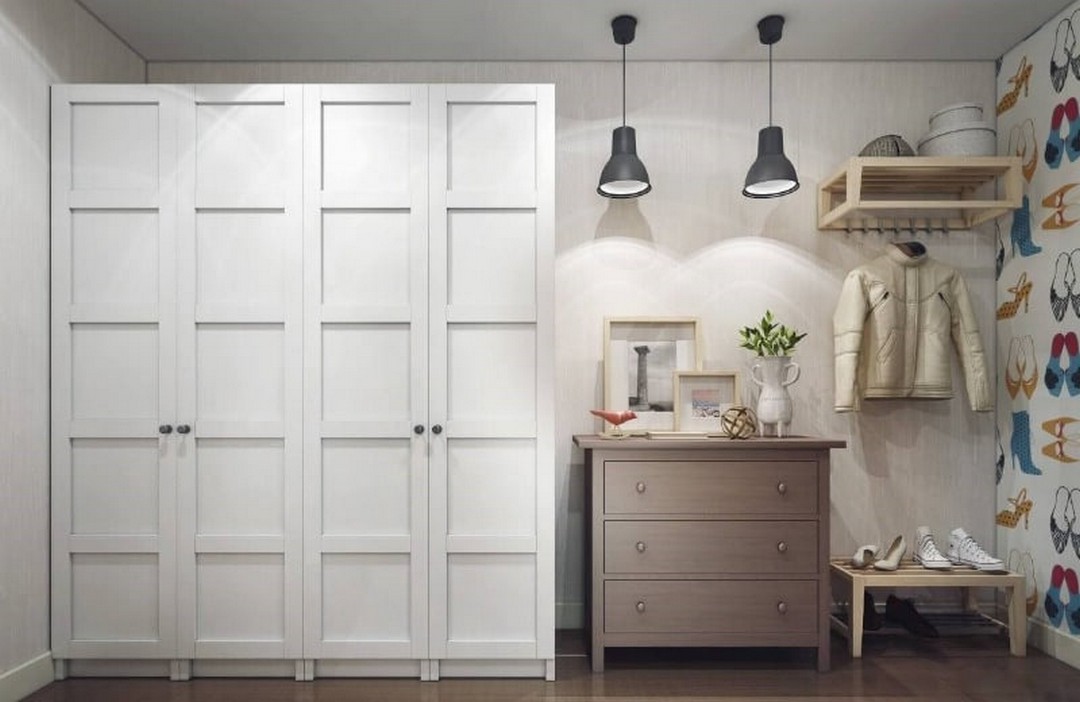
Décor
Vibrant accents help invigorate the cool Scandinavian interior. These can either be utilitarian objects or simple yet pleasant décor items, for example:
- Lamps in the form of webs, diamond or other metallic frames, tree branches, deer horns, or inverted geometric shades, which can be gilded from the inside. Garlands flickering in the warm white or yellow light are always appropriate for the bedroom, while tall floor lamps on wooden trapezoidal legs best fit in the living room.
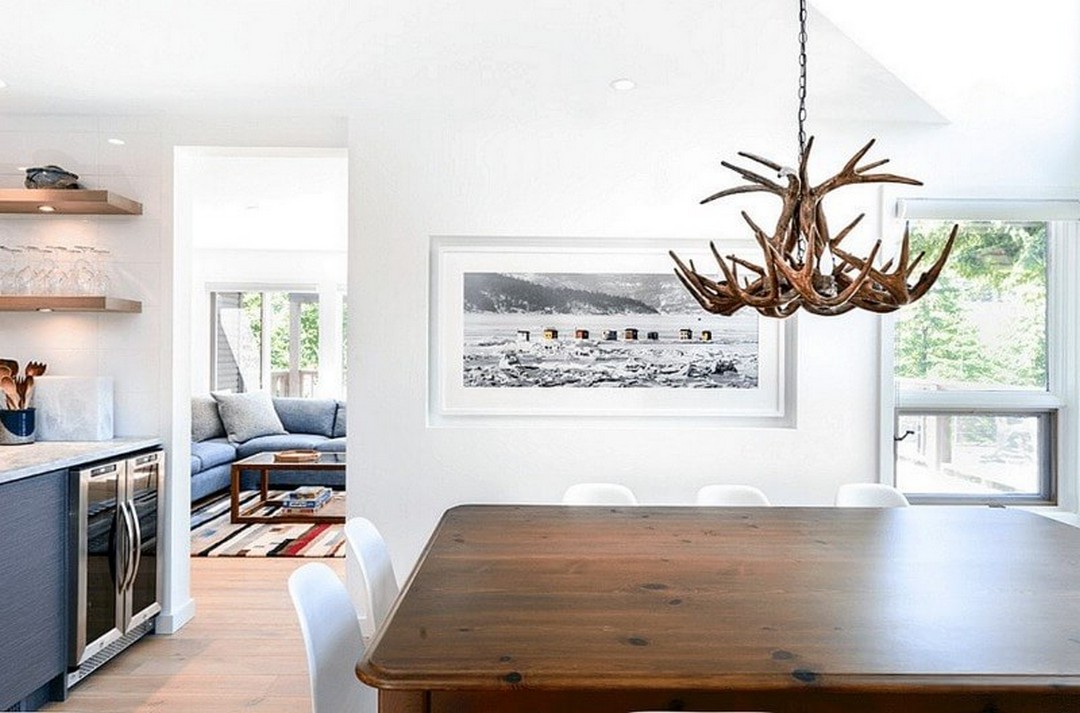
- Cushions in rich colors, with a velvety texture, abstract black and white drawings, and exotic ornaments present an easy way of infusing the room with romance and peace while improving the mood.

- Warm blankets are indispensable during the cold. The most appropriate blankets that complement the Scandinavian style are light plain woolen products, as well as large-sized hand-made knitted fringe blankets. In winter, you can use red and white blankets or those with New Year’s patterns, to reflect the holiday mood.
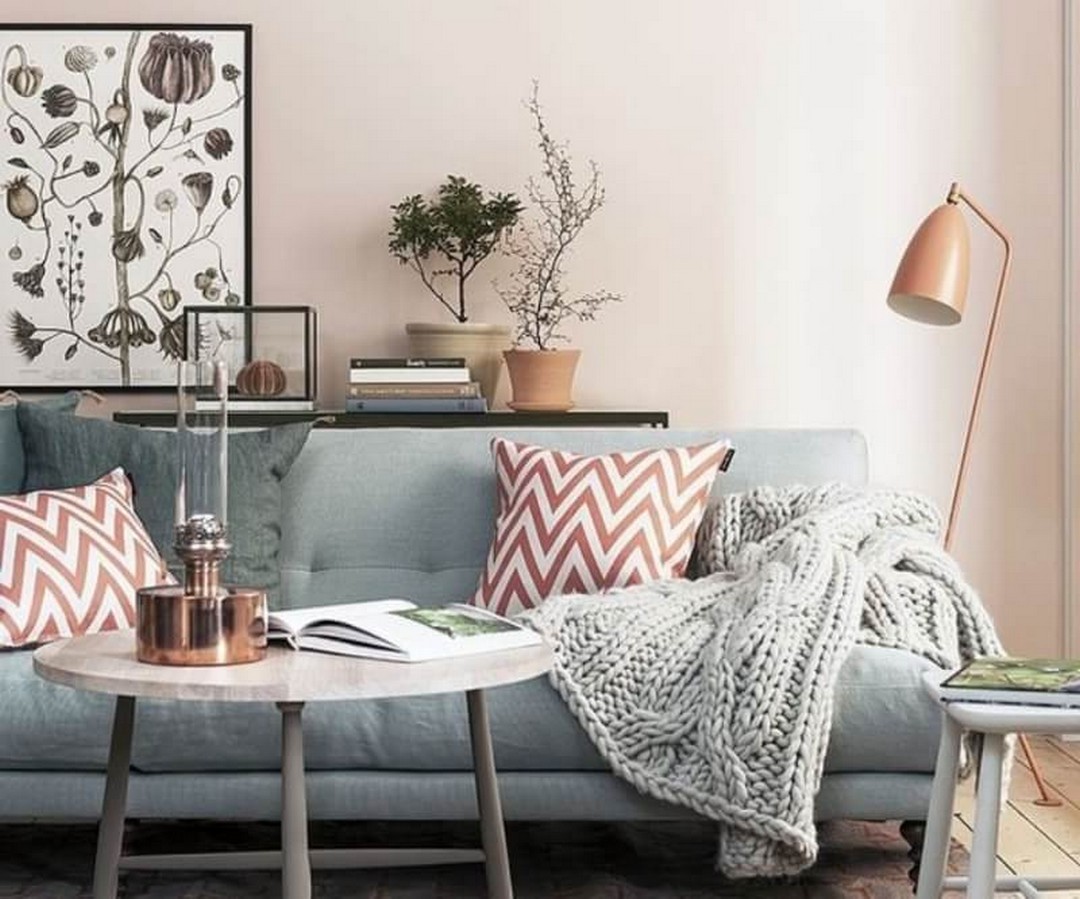
- Carpets are allowed, especially if they are fleecy. The texture of fleecy carpets is reminiscent of that of coniferous forests, moss, or dry grass. Smooth carpets also fit well into Scandinavian interiors. Smooth carpets are often slightly dusted and ideally have a grayish tint, even if they consist of colored threads. Triangles, rhombuses, traditional Icelandic and Norwegian motifs are often found on these carpets, to reflect the roots of the Scandinavian style.
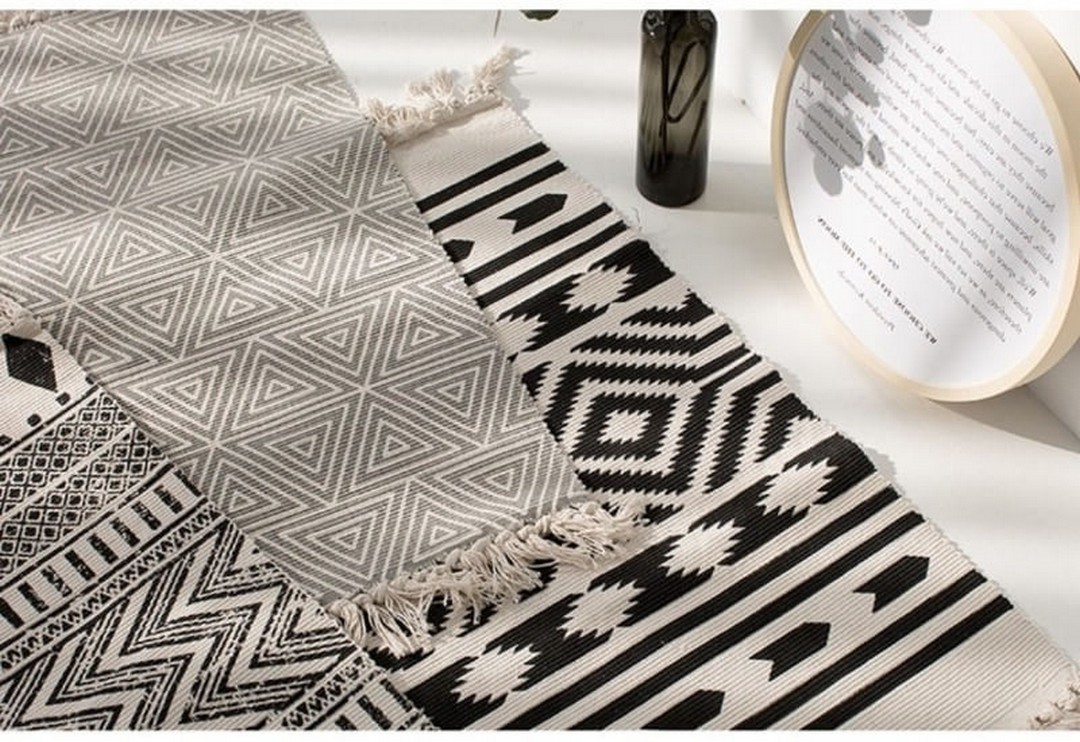
- Small decor items are popular in Scandinavian interiors. Often, these décor items come in form of pictures of northern landscapes, black and white photos, or discreet abstract wall paintings. In some cases, candles, including electric candles with a warm white glow, lanterns, textured vases, crafts made from natural materials such as wood, barks, or cones breathe life into Scandinavian interiors.
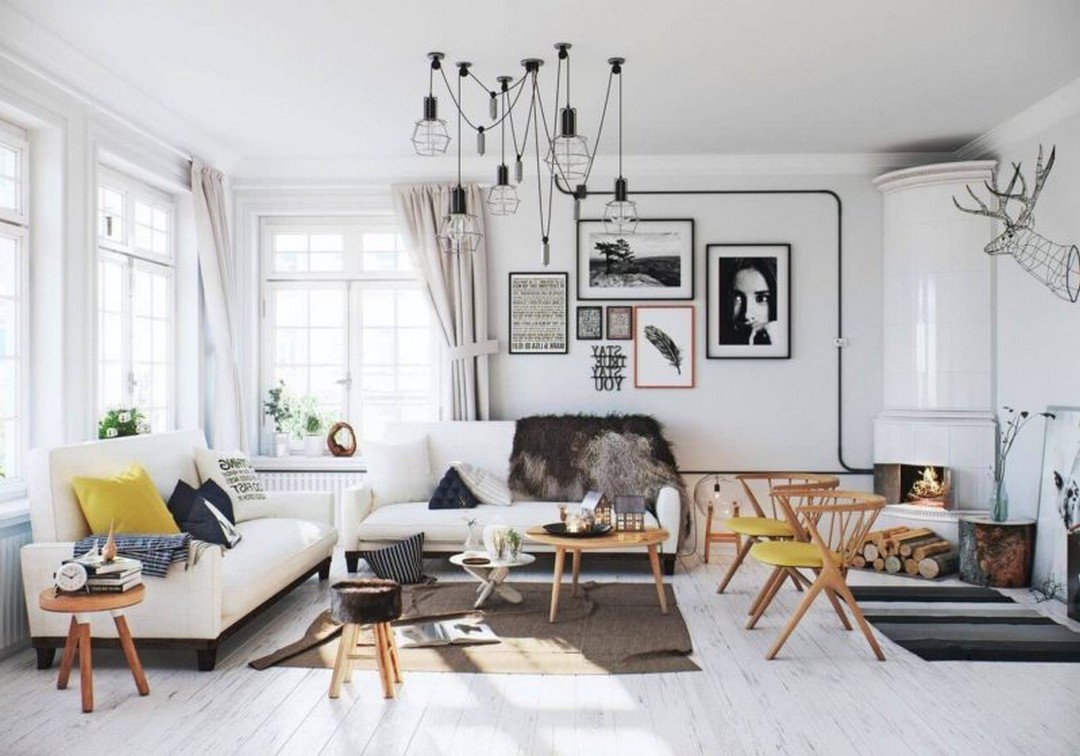
Bright and original decor breathes life into an otherwise boring Scandinavian interior
Most popular colors and shades
As mentioned earlier, Scandinavian motifs most often use white or light gray tones. For the most part, homes in Northern Europe consisting of white walls and ceilings. Northern Europeans love white for the following reasons:
- Visual increase in the size of the room:It is a well-known fact that darker colors make spaces appear smaller whereas lighter shades visually enlarge interiors. This principle formed the basis of the Scandinavian style. Snow-white walls, as used in the Scandinavian style visually increase the area a small room, making it appear more spacious due to the abundance of air and light.
- Proper penetration of light: The white finishing repels the light, thereby distributing it evenly throughout the room.
- Perfect background: Using white allows you to add accent details in absolutely any color because white goes with any color. By adding a few bright elements into a white room, you can radically improve its appearance and boost its mood.
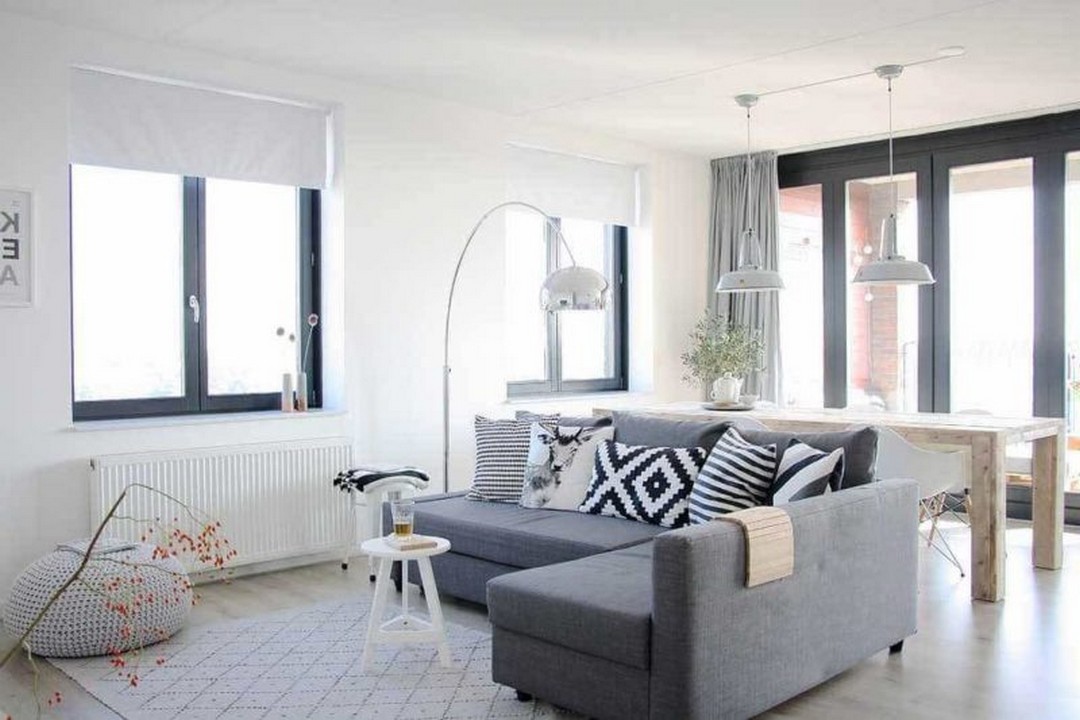
However, while white goes well with any color, caution should be exercised when using pink or yellow accents. You should ensure that you use these colors minimally if the interior is predominantly white. The main companion of snow-white is black. Of course, for a Scandinavian interior, the black should be used in a lesser proportion compared to white since the basis of Scandinavian interiors is white backgrounds. In some cases, dark-gray tones are also used as a complement to white. To harmonize these contrasting colors, it is recommended you add several wooden pieces to the room. Wood will definitely make your interior appear harmonious and stylish. Against the background of the sharply contrasting colors, wood infuses the room with warmth and coziness. Light wood such as birch and pine is the most fitting for Scandinavian interiors. You can use wood for flooring, facades, shelves, and so much more.
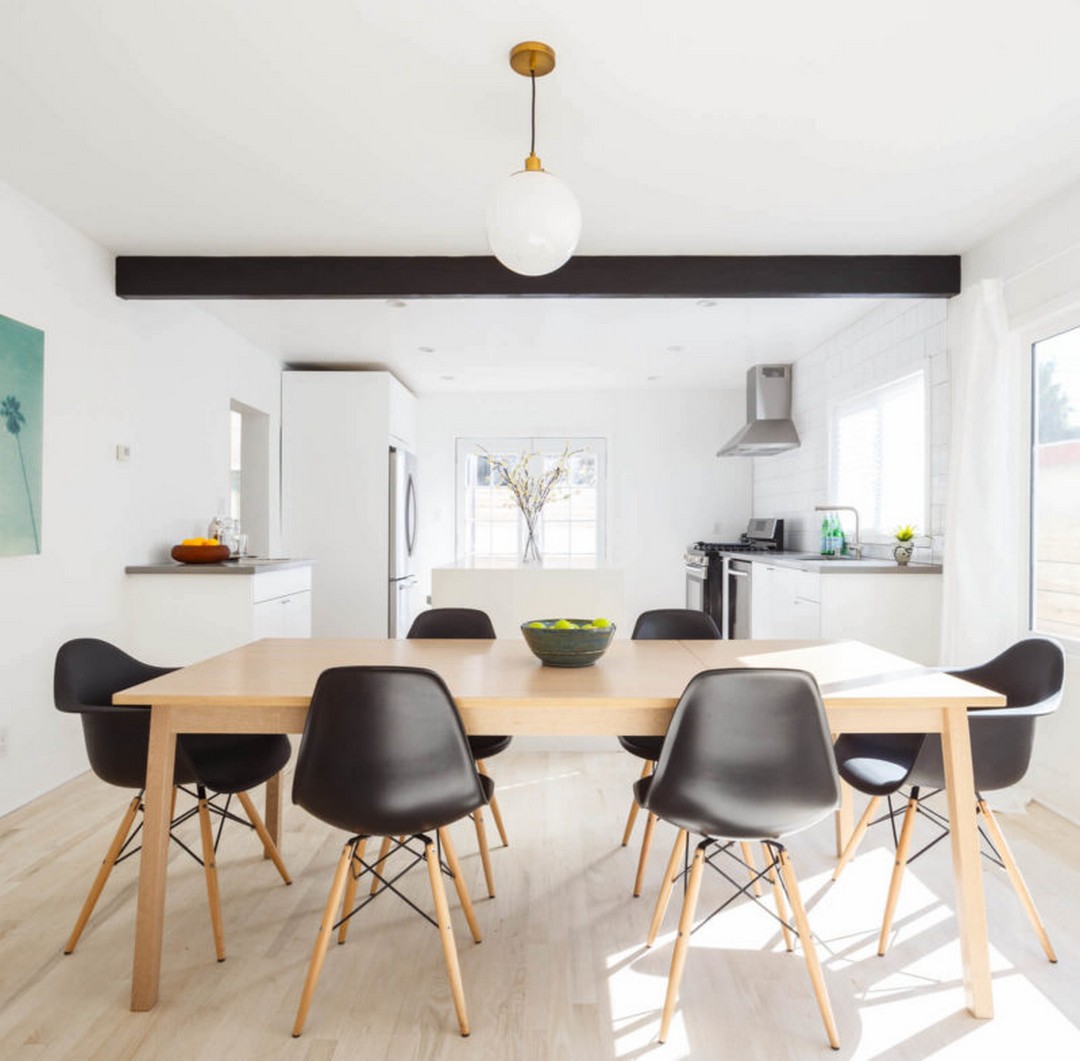
Wooden table in a Scandinavian kitchen
While bright objects are necessary so as to bring life into a Scandinavian interior, you should be careful so as not to over saturate the interior. You can achieve this by introducing a few outstanding bright pieces, either one large object like a sofa, chest of drawers, or table or a few smaller pieces such as paintings, curtains, or shelves.
Scandinavian-style lighting
Large panoramic windows are ideal for Scandinavian interiors as they ensure the interior is flooded with light. However, it is not always possible to obtain the desired amount of natural lighting, even with large windows. All professional designers unanimously reiterate the importance of sufficient and strategic artificial lighting sources for Scandinavian-style rooms. For Scandinavian interiors, one central source of light such as a chandelier is not enough. To achieve the best lighting, you should utilize a combination of diverse lighting devices, particularly the ones described below:
- Ceiling lights: For a Scandinavian interior, the ceiling lights should ideally be modest chandeliers made of wood, glass, or metal. Such lamps should be distinguished by their conspicuous simplicity, especially with regard to design and colors. If you want the ceiling lights to become a highlight, you should go with lights that have unique geometric shapes.

- Floor lamps or sconces: The simplicity promoted by the Scandinavian style is reflected in the use of simplistic forms of lighting, as stated earlier. Therefore, you can select metal sconces or floor lamps in dark shades and industrial designs. Spotlights present a unique solution.
- Table lamps: The bases of table lamps are often made of natural wood. In addition, the Scandinavian style goes well with table lamps made of copper or brass.
- Decorative lamps: Often, these lamps are similar to portable flashlights. Due to their small size, they can be placed on shelves, cabinets, or windowsills, thereby creating a cozy atmosphere.
- Garlands: These devices present quite an outstanding way of decorating the interior. Retro-style garlands have traditionally decorated many Scandinavian-style rooms.
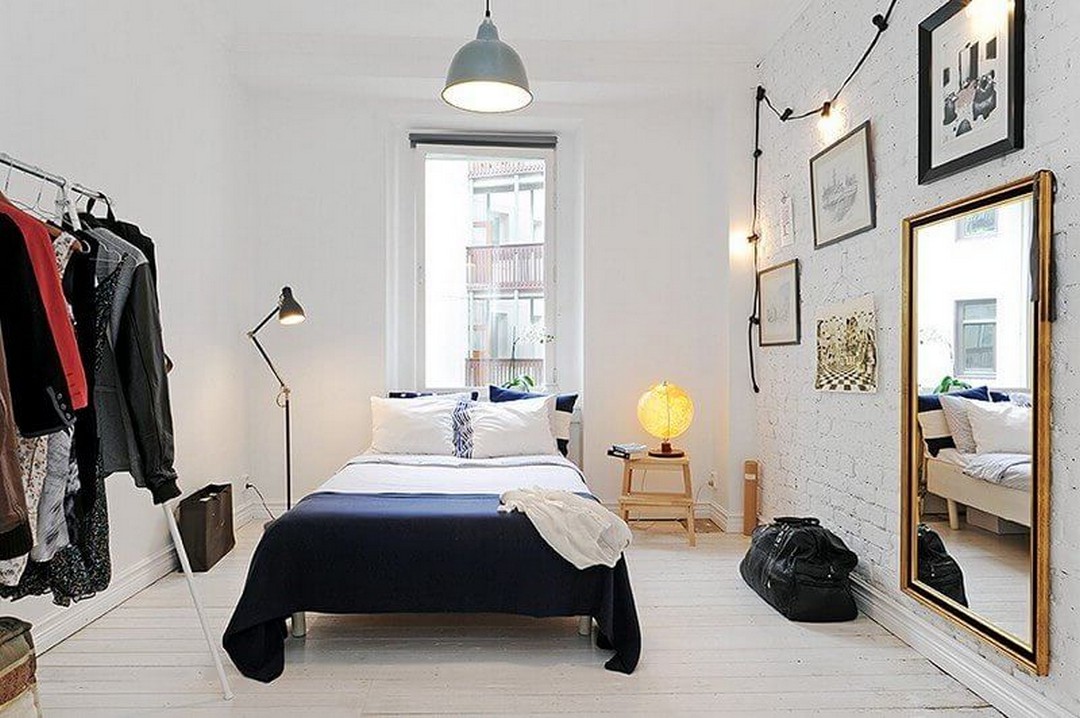
Garlands in the Scandinavian interior
When selecting the lighting devices, ensure you take into account the dimensions of the room. Also remember that floor lamps or sconces should not be the primary sources of light for your interior, since they are mainly decorative elements. You should, therefore, position these devices to highlight the area you want. This way, you can create the best Scandinavian comfort in your home.
Scandinavian style living room
The living room is the heart of any home. After all, it is here that people relax in the evening with their families and also entertain friends and guests. In most cases, the living room does not have any functional role. Still, the living room needs to be designed and decorated well to ensure comfort and coziness. One of the most important aspects to pay attention to when designing the living room is ensuring the proper arrangement of all the components of the room for ease of movement. Of course, it goes without saying that the less cluttered the living room is, the easier it is to clean, and the core spacious and beautiful it appears.
Based on the information from the previous section, you can clearly see that the Scandinavian style is the perfect solution for the living room. Scandinavian living rooms are not only cozy but also modern. Thus, you can be sure that your living room design will remain relevant for quite a while. Also, the resources you spend on natural and environmentally-friendly materials for your Scandinavian living room will pay off not only with the attractive appearance of the result but also with the durability of the items.
Also, the Scandinavian style is suitable for people who quickly get bored. Unlike baroque or high-tech styles, the Scandinavian style can easily be altered with minor alterations, such as changing the accent details. Adding new throw pillows or shelves can transform a Scandinavian interior beyond recognition.
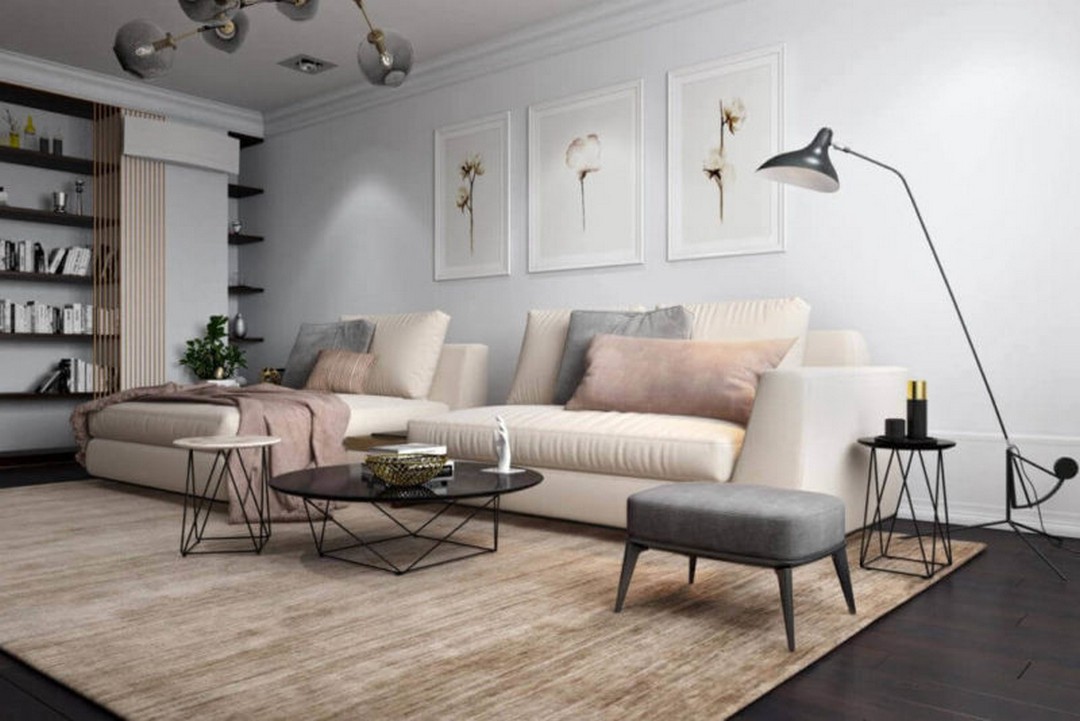
Scandinavian style living room
To get as much sunlight as possible into your Scandinavian interior, you have to sacrifice long and large curtains. In most parts of Northern Europe, people prefer roller blinds, blinds or even just bare windows. If you need to protect your eyes from the sun, thin and transparent tulles would be perfect since they minimize the amount of natural light entering the room.
The classic version of the Scandinavian living room, has a snow-white ceiling and walls, a floor made of light wood such as parquet or its imitation like laminate, a sofa or armchairs with natural fabric upholstery, a small coffee table and flowerpots with living plants or artificial plants (although real plants are preferred), and small bright accents such as pillows, floor lamps, and chandeliers.
For those who collect books or love to read, it would be appropriate to combine the living room with the library, particularly if your interior is small. This way, you can comfortably read in an armchair. For the Scandinavian style, designers recommend shunning closed cabinets in favor of open shelves or racks made of both wood and metal. Open shelves take up minimal space and are not only practical but also stylish.
Features of the design of the kitchen and dining room
The basis of the design of the kitchen is the familiar combination of white and black tones. The kitchen is one of the most functional rooms, so the Scandinavian design principles come in especially handy. Wooden facades in combination with the apron slightly dilute the monotony of the black and white, giving you a bright, relaxing and comfortable space that is perfect for preparing meals and enjoying them with the entire family.
Studio apartments are becoming increasingly popular. By combining the living room and kitchen/dining areas, it becomes possible to save on space in the home, making your interior more spacious and free. However, with this approach, you get more space for the living and dining room zones, while sacrificing on the kitchen area.

Small Scandinavian style kitchen
However, you need not worry about this if your interior is Scandinavian, as you can easily carry out territorial planning. It is important to only install the functional items in such an interior, in order not to overload the space. With this approach, you will have a competently-furnished kitchen where each item fits in seamlessly, making it easy for you to prepare food and clean up.
The main principles of the Scandinavian style, such as the use of light shades on walls and ceilings, facades of light wood, as well as the proper arrangement of lighting devices, come in handy for small kitchens as these techniques add space to your kitchen and visually increase its area. You can accentuate your Scandinavian kitchen with appliances in retro style. These appliances should ideally have unique designs and bright colors since they are meant to serve as bright accents and refresh the look of your kitchen.
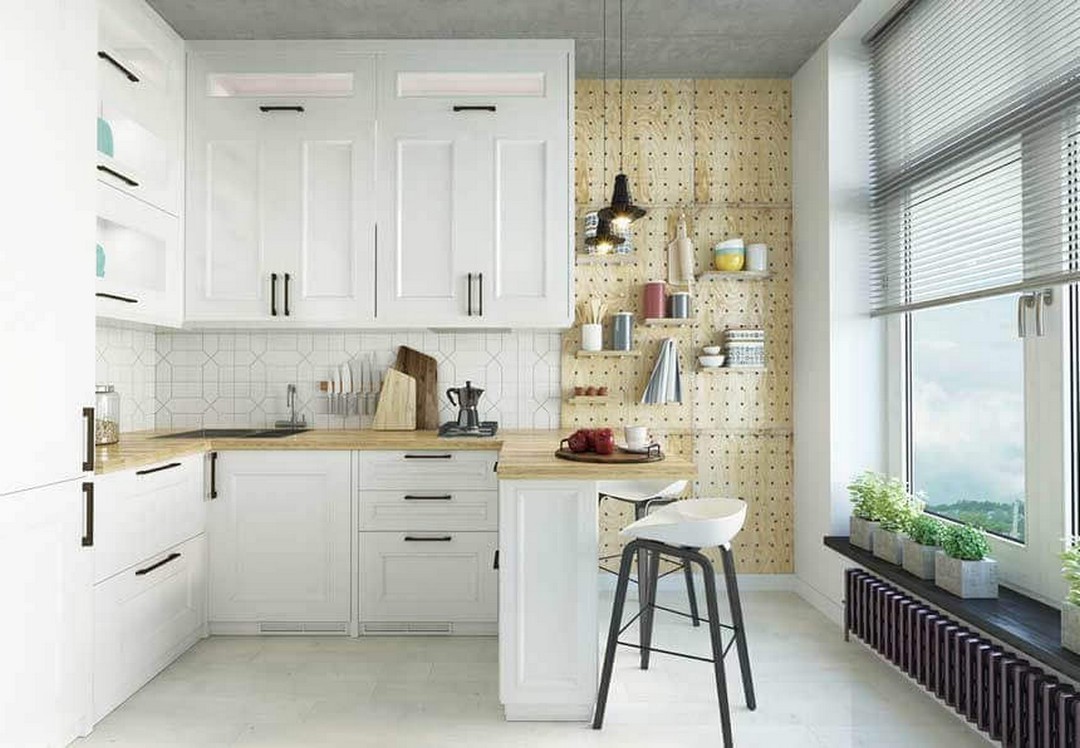
Scandinavian bedroom – How to combine comfort and practicality?
Many people spend the bulk of their time in the bedroom. For this reason, you should design and decorate your bedroom for maximum comfort. In contrast to other spaces such as the kitchen, the bedroom has very few practical items, except perhaps a bed or wardrobe. In principle, it is inappropriate to place too many furniture pieces in the bedroom. In addition to the bed and closet, you can spruce up your bedroom by adding bedside tables and additional lighting systems such as sconces or floor lamps.
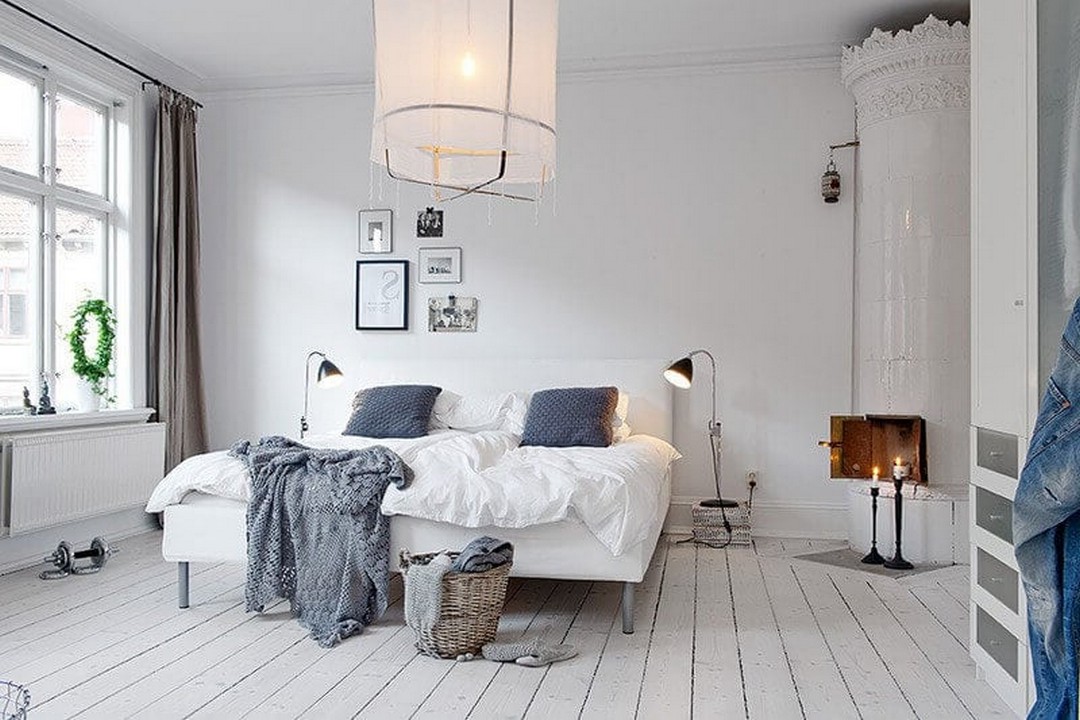
Scandinavian-style combined bedroom lighting
The accent wall, i.e. one of the walls of the room stands that stands out from the others with the help of unique finishing like wallpaper – is quite popular in Scandinavian-style bedrooms. Instead of painting a different color on the accent wall, you can use a different wall finishing like wallpaper or decorative plaster for the accent wall. In case you opt for an accent wall, for instance in the headboard area, it is important that the other three walls be left as intact as possible.
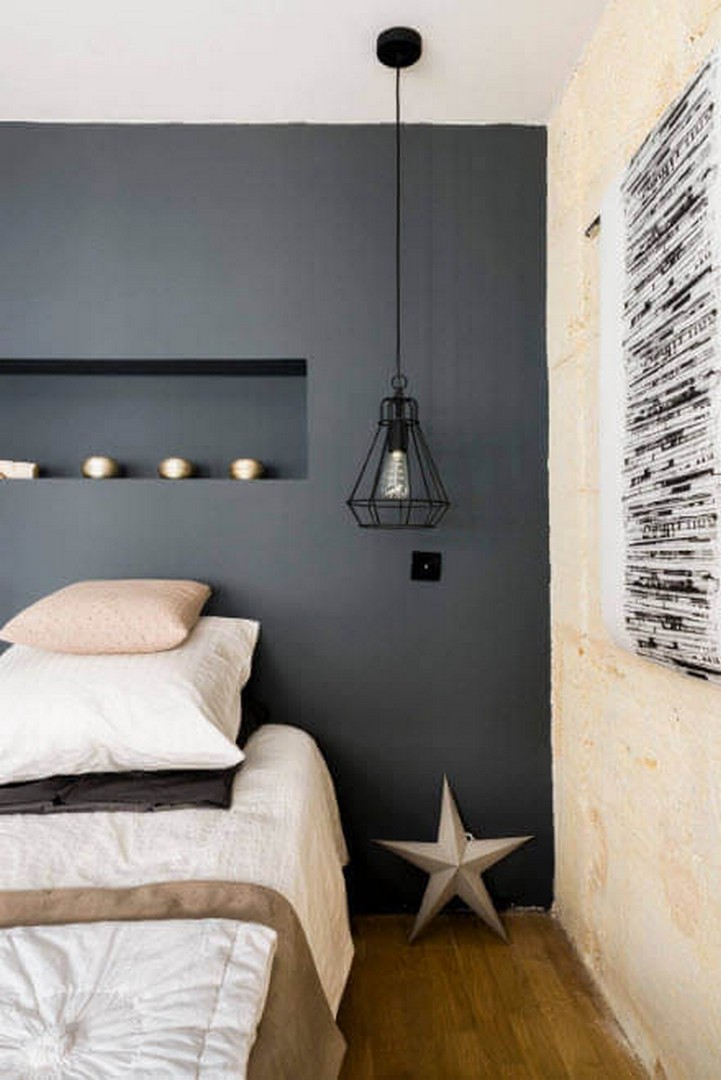
Accent wall in the bedroom
Use natural wood materials to add warmth to the space. Wooden decor creates an indescribable cozy atmosphere that favors sleep and relaxation. Wood can be used anywhere in the bedroom, from the furniture to the flooring. You only need to ensure that the wood is in harmony with other elements of the room. There are unlimited types and designs of wooden design and décor types. You will easily find items that match your budget and taste.
Whereas the retro style combines perfectly with the Scandinavian-style kitchen, Scandinavian-style bedrooms blend in perfectly with classic elements. For example, the use of wicker furniture or decor will give the room a charming feel. You can even introduce beautiful garden chairs in the bedroom if you have the space, and use a wicker basket as an organizer for your newspapers and magazines. Many designers suggest using artificially-aged furniture as it gives a stylish and original look that is just perfect for the bedroom.
Scandinavian minimalism in other rooms of the house
In addition to the main rooms discussed until now, let’s look at other rooms in which the Scandinavian style can be useful.
Children’s rooms
Often, parents prefer to design rooms for their children in the Scandinavian style. The main advantage of this choice is the ability to remodel the interior depending on the age of the child without major investments. You can completely transform the space by simply overhauling some pieces of furniture or changing accent colors. In addition, natural wood furniture, a key element of the Scandinavian style, is highly suitable for children’s spaces. This is because wood is an environmentally-friendly material that is also friendly to the health. Minimalism, which should be adhered to when designing any Scandinavian interior, will give the child more space for indoor activities.
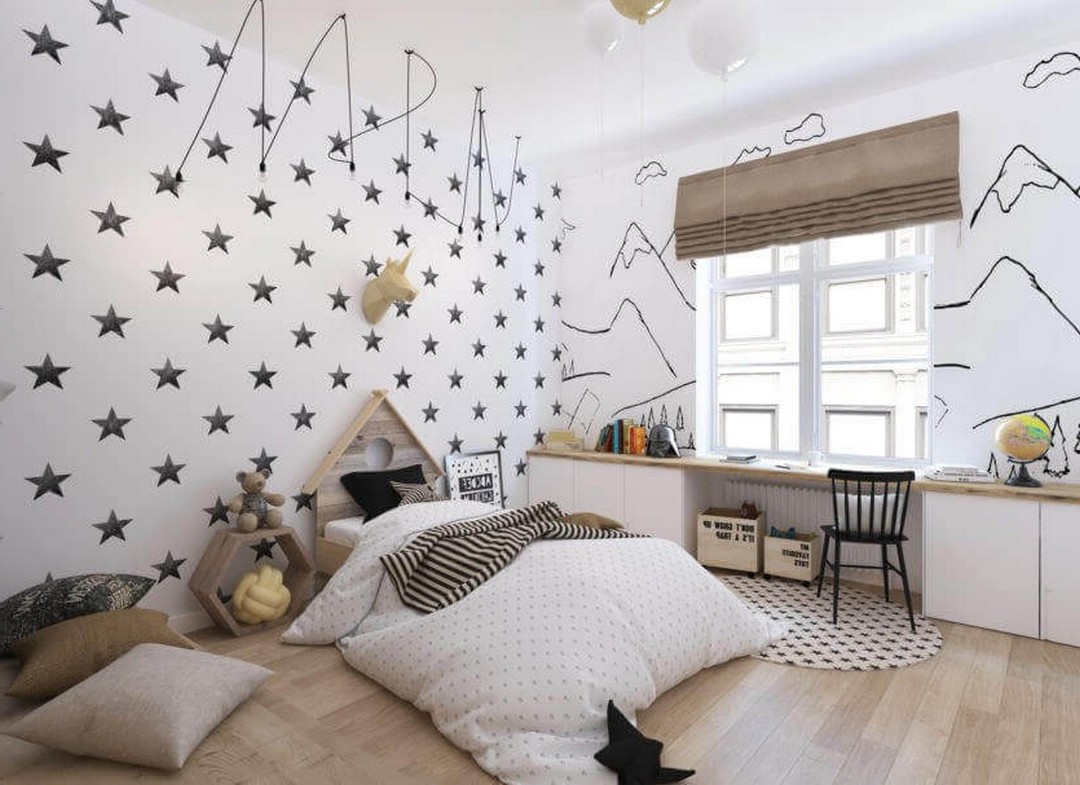
A Scandinavian-style kid’s room
As for the decor elements, the following details are the most popular:
- Wooden or wicker baskets for storage of toys and other items.
- Living indoor plants that give a sense of freshness.
- Rugs with unusual patterns.
- Large and soft decorative pillows.
- Additional lighting: In addition to the main chandelier, garlands, floor lamps or wall lamps are suitable.
- Posters, paintings, paper flags, etc.
- Toys:There are plenty of toys that fit perfectly into the Scandinavian interior. You do not necessarily have to choose pastel-colored toys. Instead, you can go for bright dolls, teddy bears or cars, as these create a great accent.
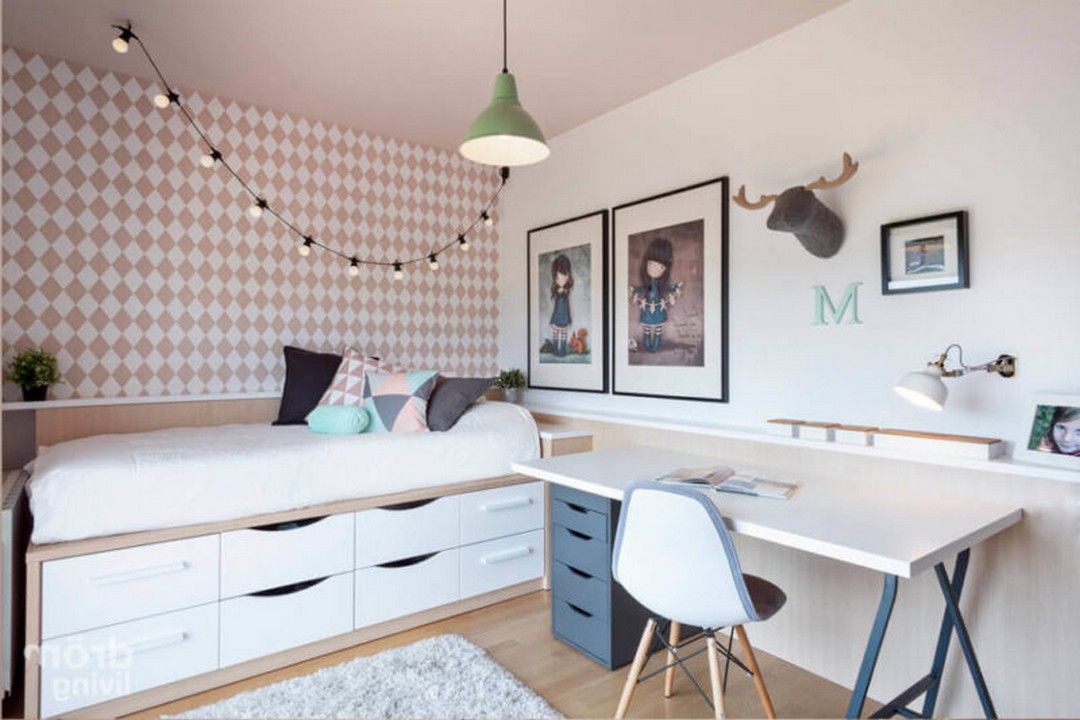
Decor for a kid’s room
Study
Many people are increasingly working from home. Unfortunately, the limited space of most homes does not permit the creation of an office. Most people partition off small sections of the bedroom or living room to act as their home offices. In any case, it doesn’t matter whether you have a separate room for the office or just a couple of square meters. With Scandinavian-style design techniques, you can create the perfect and most efficient home office.
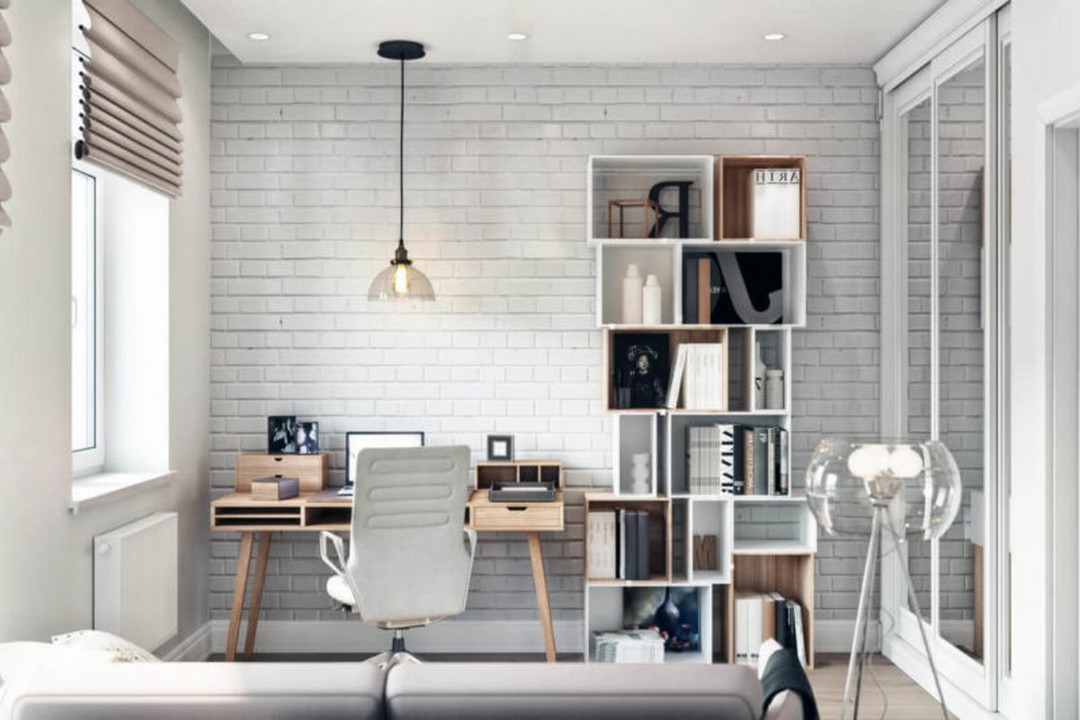
Scandinavian-style study
All that is needed for the design of a home workspace is a desk or table, ideally with a pedestal and open storage systems like shelves or racks. The Scandinavian style shuns any manifestations of excessive luxury, making the style ideal for planning a study at home. Special attention should be paid to decorative elements. For an office in the Scandinavian style, the following elements are perfect:
- Motivational posters.
- Photos of your special moments or people.These can be arranged as a collage or one by another.
- Living plants:A simple plant like a cactus placed near a computer monitor is considered a classic.
- Any item that inspires you:Remember that the workplace environment should inspire productivity. Therefore, as decor, you can use any elements that raise your mood. From your favorite figurines, to magazines, or flower vases.
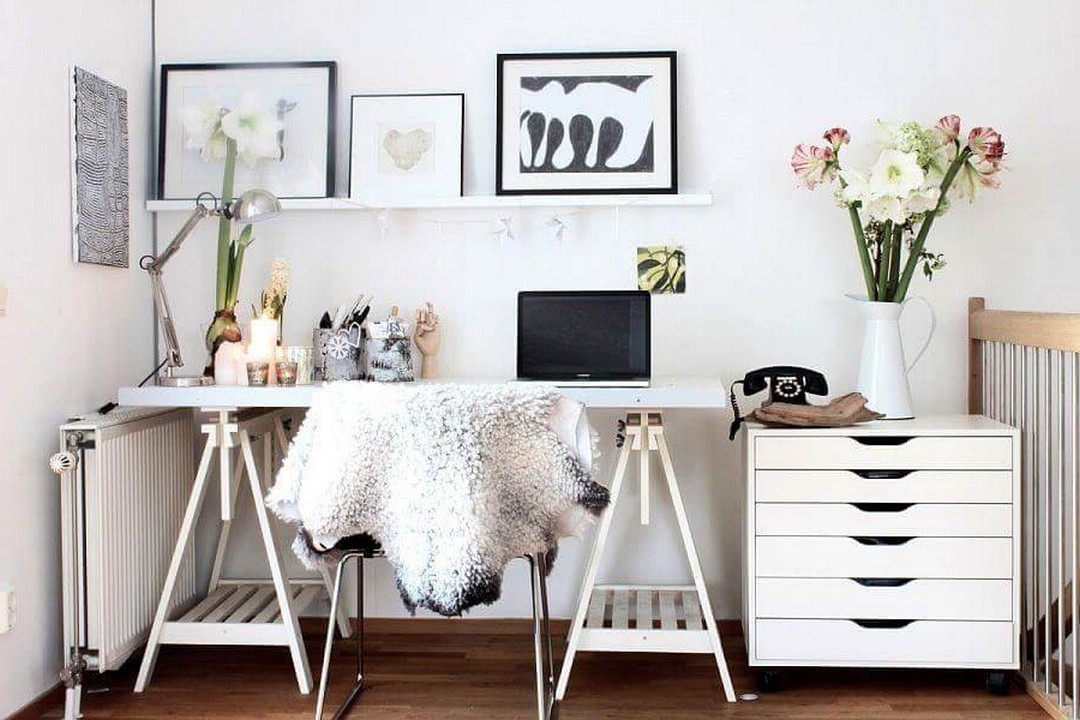
Posters, vases and candles – the main decor of the Scandinavian interior
Bathroom
Like other rooms in the Scandinavian style, the bathroom should be as light and spacious as the conditions allow. Scandinavian motifs are ideal for the design of the bathroom. You can use light walls and a dark floor to create an appealing contrast. In addition, plumbing, which is mostly white, looks more impressive against a black floor finishing. However, it is not customary that you use wooden elements in the bathroom. However, these elements are desired as they give the room warmth and originality. To protect the wood from water and moisture, you ought to treat it with special chemicals. After treating the wood, you can comfortably use it for shelves or countertops.
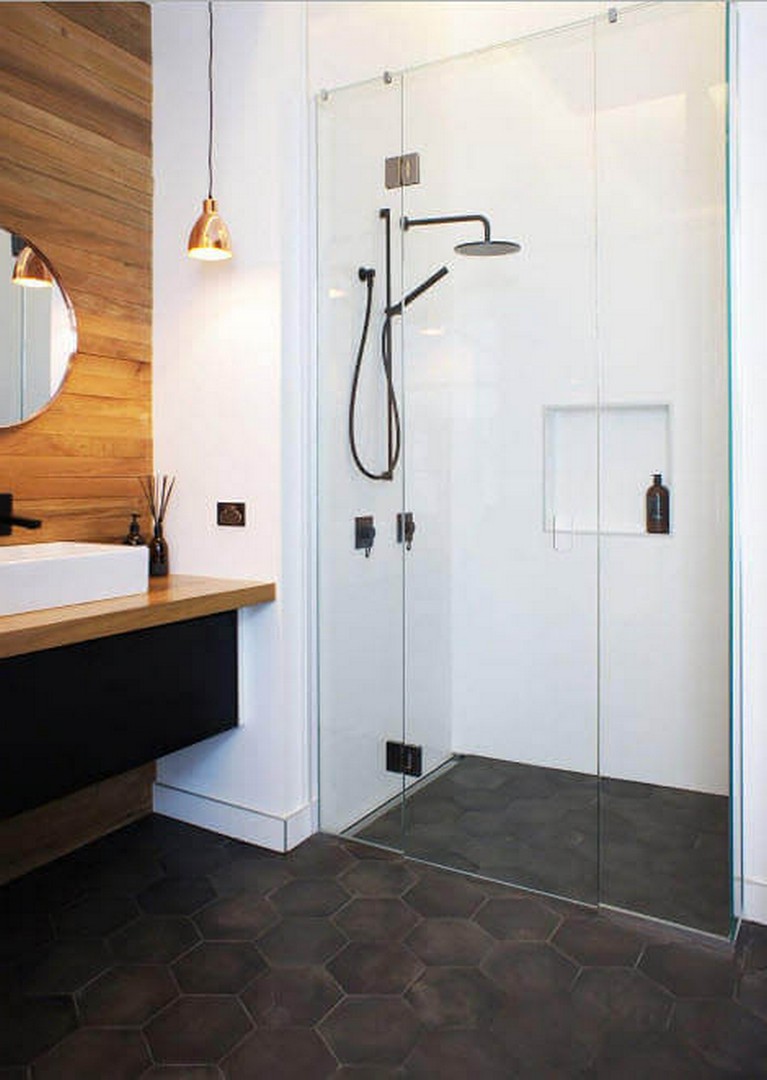
Balcony
The loggia is an important part of any home. Previously, people stored unnecessary items such as bicycles, sledges, strollers, or boxes on the balcony. Today, the balcony has become an island of sorts, created to allow rest and relaxation. Make your space as free as possible, while opening it up to sunlight and clean air.
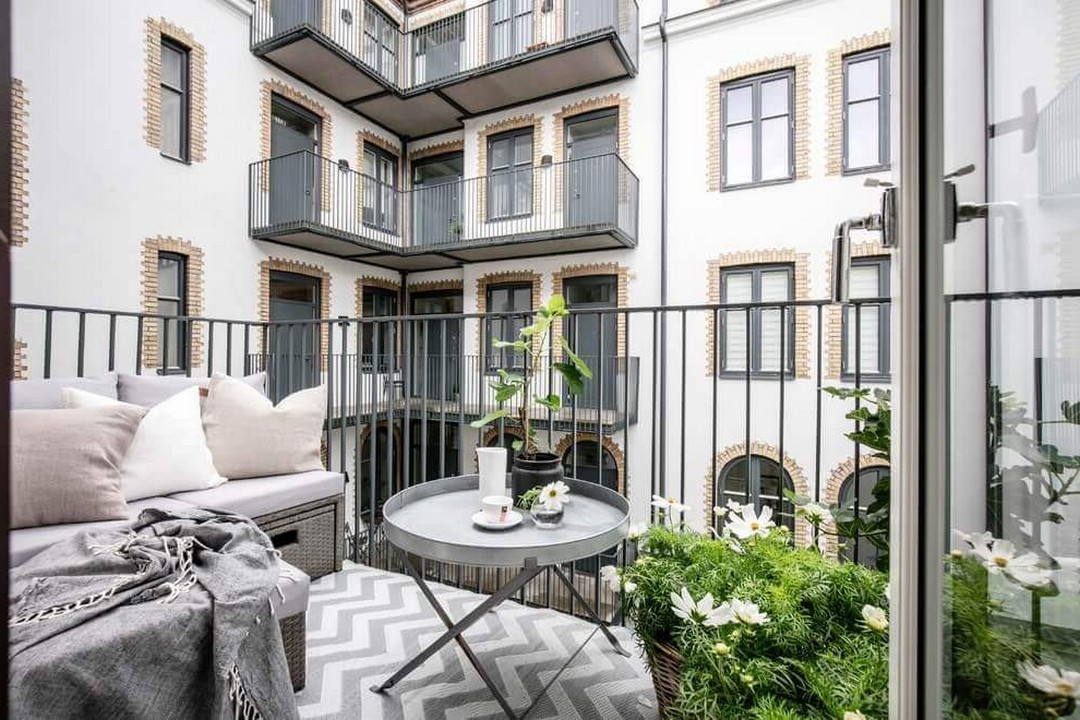
Scandinavian style loggia
In the design of the balcony walls, an ordinary wooden lining or brick painted in light pastel colors does the trick. You can additionally use pillows or rugs as decor. These items not only create coziness, but also help keep you warm in cold weather. You also need to pay attention to the lighting, even on the balcony. Floor lamps with thick wires or elegant candles on the balcony will give you comfort.
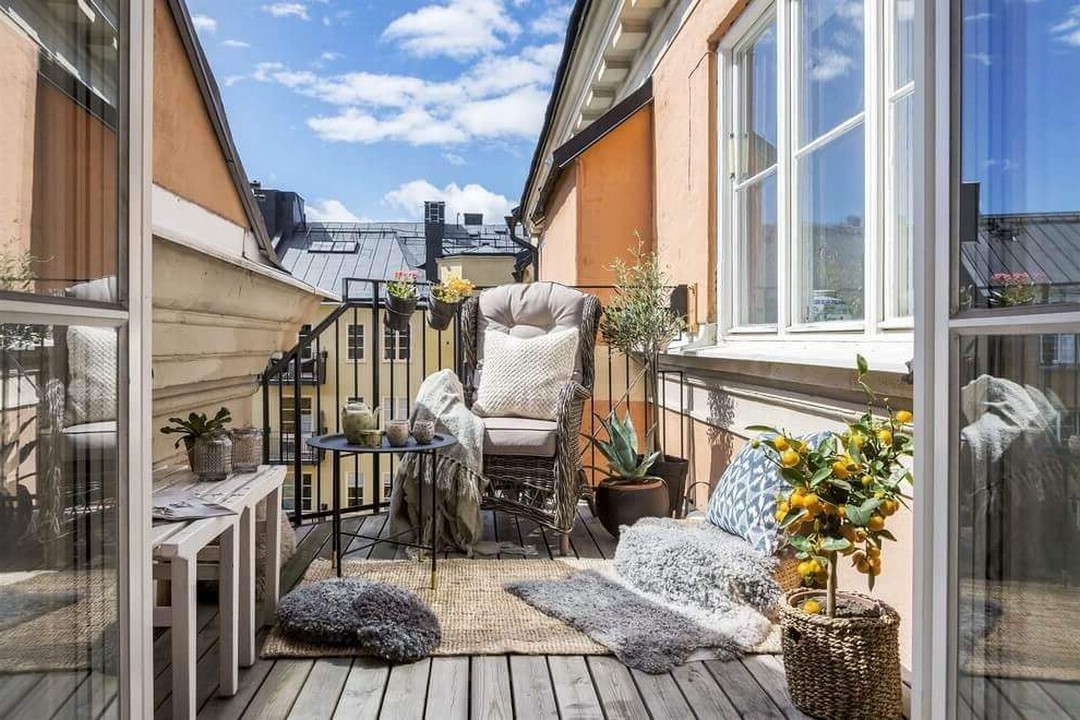
Plaid and pillows as a decor of the balcony
The Scandinavian style can be applied to all other areas of the home, even the corridor. The famous clarity and simplicity of the lines in the Scandinavian style and the perfect combination of beauty and practicality is facilitated by the proper design of the space, where each element has its place and fulfills its purpose. The minimalism principle of the Scandinavian style makes the interior incredibly free, convenient and easy to clean.


